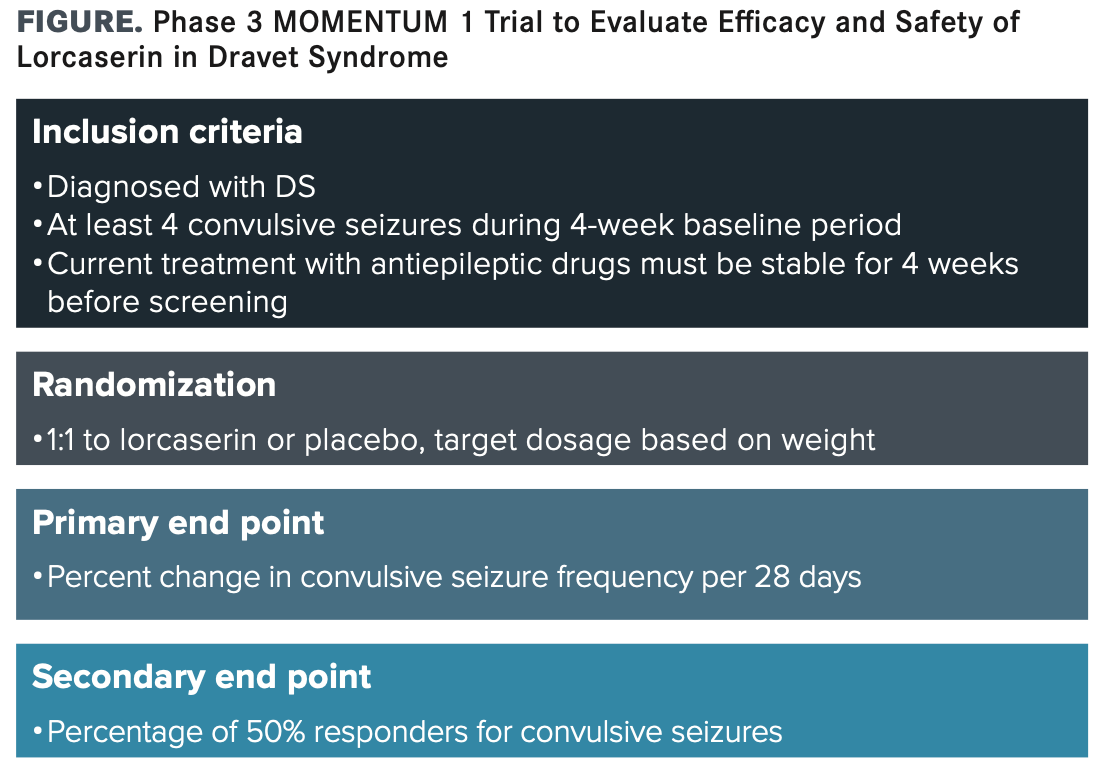Publication
Article
NeurologyLive
Eisai Targets Dravet Syndrome Indication for Lorcaserin With Multifaceted Study Design
Author(s):
Michael Irizarry, PhD

Lorcaserin aims to become the next FDA-approved treatment for patients with Dravet syndrome. Developed by Eisai, the selective serotonin 5-HT2C receptor agonist will be used as an adjunctive treatment in the recently initiated phase 3 MOMENTUM 1 clinical study (Study 304; NCT04572243), which will evaluate the agent in patients with Dravet syndrome (DS) and is expected to be completed in December 2021. Additionally, Eisai announced it will continue the lorcaserin expanded access program through Study 405 (NCT04457687), also known as the MOMENTUM 2 study.1
It originally served as the primary ingredient in Belviq, a weight loss medication from Arena Pharmaceuticals. The CAMELLIA-TIMI 61 study (NCT02019264) indicated that the drug sustained weight loss without a higher rate of major cardiovascular events compared with placebo.2 However, it also showed an imbalance in the number of patients with malignancies, and lorcaserin was subsequently withdrawn from the market.1
At the time, Belviq maintained off-label use as a treatment for the disorder and other refractory epilepsies. Eisai noted that it had received multiple requests from patients, caregivers, and health care professionals for continued access to lorcaserin for patients who were prescribed Belviq to help treat DS and these refractory epilepsies. The requests prompted a consultation with the FDA, which agreed with Eisai about the importance of patient access to lorcaserin for DS. Furthermore, the agency noted that this access would be granted based on the extent of each individual’s health care provider’s belief in the continued access as medically appropriate.
The unique mechanism of action of lorcaserin as a selective serotonin 5-HT2C receptor agonist unsuppressed neuron firing in patients with DS. “Over 80% of cases are caused by a sodium channel mutation. That sodium channel mutation particularly impacts GABA (γ-aminobutyric acid) inhibitory interneurons. Those neurons can normally suppress firing, and it’s thought that when that inhabitation is released, it increases the susceptibility to seizures,” Michael Irizarry, PhD, vice president of clinical research at Eisai, told NeurologyLive.
In a preclinical zebrafish model, lorcaserin was used to treat 5 patients with medically intractable DS and showed promising results in terms of reductions in seizure frequency and/or severity. Investigators noted a 65% reduction in seizure frequency during the first 3-month treatment period.3 “Because it’s specific to 5-HT2C, it doesn’t have some of the same safety liabilities of other drugs that have valvular safety issues that more broadly target the serotonergic system,” Irizarry said.
Now, the focus shifts toward MOMENTUM 1, which has a target enrollment of 58 patients with DS who will be evaluated at approximately 20 sites in the United States. The study will evaluate the percent change in frequency of convulsive seizures per 28 days in patients taking lorcaserin compared with placebo (see FIGURE).

The percentage of 50% responders with convulsive seizures in the core treatment period compared to baseline will be used as a secondary outcome measure. In addition to efficacy, researchers will attempt to characterize the pharmacokinetics of lorcaserin and the relationships between lorcaserin plasma concentrations and efficacy and safety.
Patients in MOMENTUM 1 will be randomized to receive lorcaserin administered as an oral suspension twice daily for 14 weeks during the core treatment period. Dosage will be based on body weight as follows: target doses for participants weighing 10 kg to < 20 kg, 20 kg to < 40 kg, and ≥ 40 kg will be 5 mg, 10 mg, and 20 mg per day, respectively. Subjects must be aged 2 years or older at the time of informed consent, have a diagnosis of epilepsy with DS, had at least 4 convulsive seizures during the 4-week baseline period, be on a stable treatment regimen of antiepileptic drugs for at least 4 weeks pre-screening, and must be expected to remain stable throughout the study. Patients who used lorcaserin within 4 weeks or fenfluramine (Fintepla; Zogenix) within 2 months of screening, have recent or concomitant use of serotonergic medications or monoamine oxidase inhibitors, or have the presence of progressive central nervous system disease other than DS were excluded from the trial.
“Our intention would be to seek approval after this study. The way we’ve designed it, we’re looking for a large treatment effect. We believe that the safety is well understood; the key question will be the efficacy that’s determined,” Irizarry concluded.
MOMENTUM 2 will include patients with DS and other refractory epilepsies who were prescribed lorcaserin by their treating physician prior to the market withdrawal. The study will include a pharmacokinetics substudy, a retrospective chart review, and prospective data collection to gather information on seizure frequency, pharmacokinetics, and safety with lorcaserin exposure.
REFERENCES
1. Eisai initiates phase 3 MOMENTUM 1 clinical trial (Study 304) of lorcaserin in Dravet syndrome. News release. Eisai. September 30, 2020. Accessed November 10, 2020. https://eisai.mediaroom.com/2020-09-30-Eisai-Initiates-Phase-3-MOMENTUM-1-Clinical-Trial-Study-304-of-Lorcaserin-in-Dravet-Syndrome
2. Bohula EA, Wiviott SD, McGuire DK, et al. Cardiovascular safety of lorcaserin in overweight or obese patients. N Engl J Med. 2018;379(12):1107-1117. doi:10.1056/NEJMoa1808721
3. Griffin A, Hamling KR, Hong S, Anvar M, Lee LP, Baraban SC. Preclinical animal models for Dravet syndrome: seizure phenotypes, comorbidities and drug screening. Front Pharmacol. 2018;9(573):1-15. doi:10.3389/fphar.2018.00573





